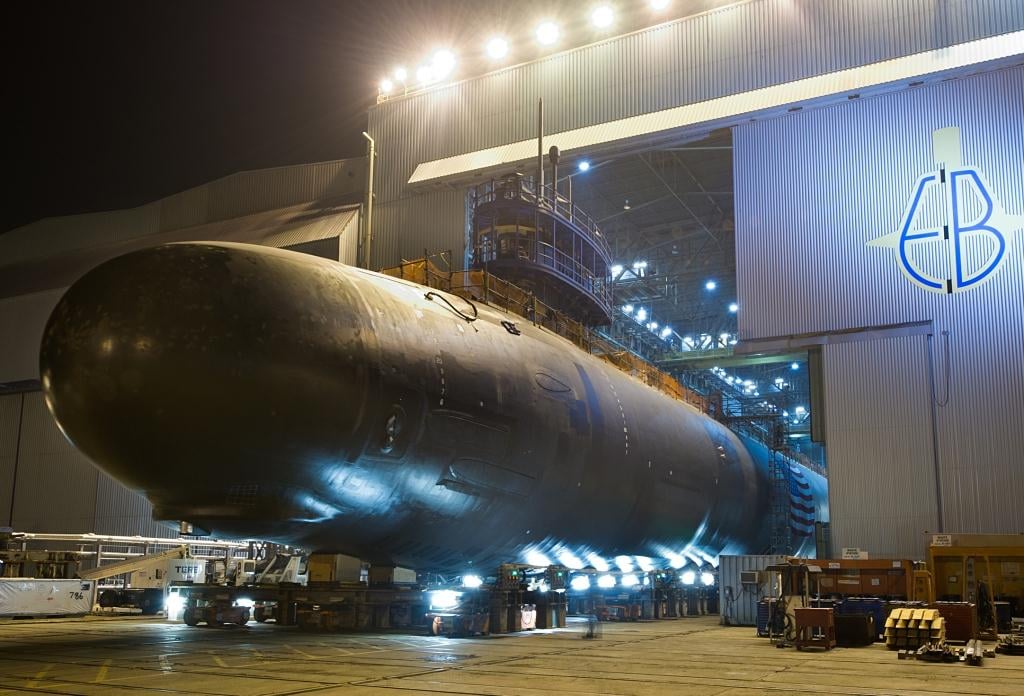
The Virginia-class attack submarine USS North Dakota.
SEA-AIR-SPACE: The Navy’s two most critical submarine programs share one big concern: the ability of an already squeezed defense industry to keep up.
“One of the biggest risks to Columbia is if Virginia gets out of its cadence,”James Geurts, the Navy’s acquisition chief, told reporters here Tuesday. The Virginia boats are already suffering delivery delays of up to seven months getting out of maintenance, potentially placing the Columbia — slated to be the backbone of the nation’s nuclear triad — at risk.
Both the new Columbia-class hulls and long-planned upgrades to existing Virginia-class subs not only share a single industrial base, but interwoven schedules that require each to hit their marks on time, meaning any slip-ups will reverberate across the entire undersea force.
Asked if the Navy would sacrifice work on the Virginia to keep the Columbia on schedule, Geurts said, “Columbia is our No. 1 priority.”
Beginning in the early 2020s, the Navy is scheduled to work on both classes at the same time, producing one Columbia and two Virginia per year. That makes getting the Virginia right a core national security issue.
“The biggest issue in the submarine enterprise is not the Columbia class per se,” Geurts said. “It’s largely tracking to the schedule we have. Obviously we’ve worked through some supplier issues and we’re holding to the schedule on those… It’s really looking broadly at the whole submarine enterprise and ensuring, as we build in the Columbia, we are in a position to succeed with Virginia and Virginia Payload Module.”

A Navy depiction of the future USS Columbia nuclear missile submarine (SSBN 826)
To do that, “we’ve got to make sure we’ve got all the sequencing right, which includes all of the facilities, workforce, and supplier bandwidth so that as we sequence in the Columbia we can continue with the Virginia.”
That’s no simple task.
The Navy is struggling with getting its submarines and surface ships out of port on time due to difficulties in getting needed parts, and having the skilled workforce available to handle the work.
And not all shipyards are created equal.
Geurts admitted that “we have not seen the performance out of the private yards that we had hoped,” but “we’re going to be working with them to improve their performance as we look at the overall sub maintenance.”
Getting these issues straight is critical not only for the Columbia, but for the recent 10-ship Block V Virginia boats, nine of which will receive the 84-foot Virginia Payload Module. The module will give the new Virginia’s triple the Tomahawk cruise missile capacity of existing boats.
Geurts isn’t the only one who is anxious.
“One of our great concerns is the vendor base,” Capt. Christopher Hanson, Virginia submarine program manager, said here Tuesday. Hanson said that the best way to stabilize that base is to make predictable, long-term plans “well in advance, and getting those dollars out there to send a very clear signal as to what is coming.”
The Navy is attempting to do that in the Block V Virginia, and placing the order for two Ford-class carriers earlier this year.
The Columbia-class is the first completely new submarine the United States has produced in decades. Their construction schedule, which begins in 2021, has no room for error since the Columbia will replace the maxed-out Ohio-class nuclear submarines, which are slated to begin retiring in the next decade.
Asked what might slow down the program, Columbia program manager Capt. John Rucker answered simply, “the supplier base.”
The Navy’s long gap between the last new submarine build and the Columbia comes after “we as a government, we as a country — you included, taxpayer — made a decision to go down to low rate production,” he said. “Now we’re ramping back up to where we were in the 1990s. But the qualified, fully-capable high-production workforce, they’re not there today.”
He said the Navy’s usual shipyard partners are ramping up hiring, and the state governments of Rhode Island, Connecticut, and Virginia have established training programs for skilled workers.
Geurts said that those shipyards are “in pretty good shape with the submarines in there now. But what we need to do is continue with work with the shipyards and continue with the optimization program as the submarine number comes back up [to ensure] we’ve got everything in place to handle that demand as it grows as we head towards 66 submarines,” in the coming decades.
“Right now, he added, “we’re using private yards to help with some surge support. The sub inventory dips down a little bit” in the coming years, but “we’ll use that dip down time to really rejuvenate the public yards.”
Multi-ship amphib buy could net $900M in savings, say Navy, Marine Corps officials
Lawmakers gave the Navy authorities to ink a multi-ship amphib deal years ago, but the service has not utilized that power yet.


























